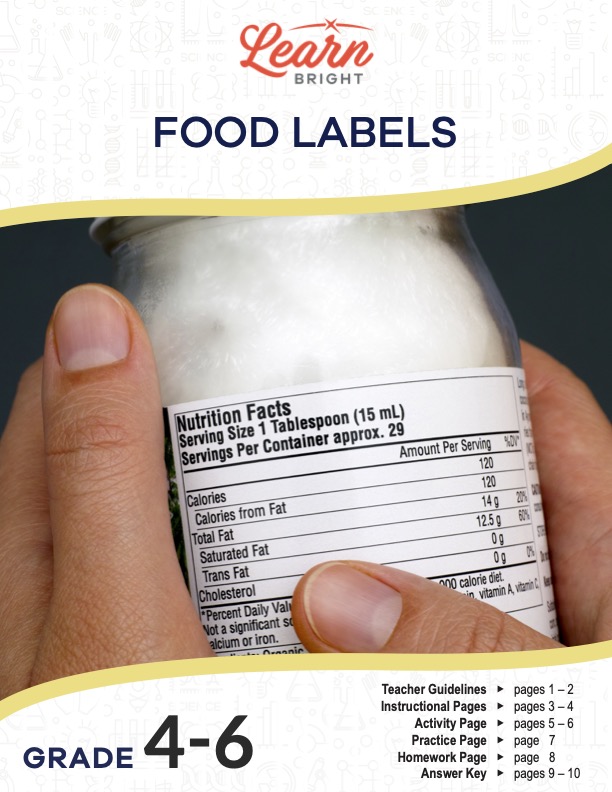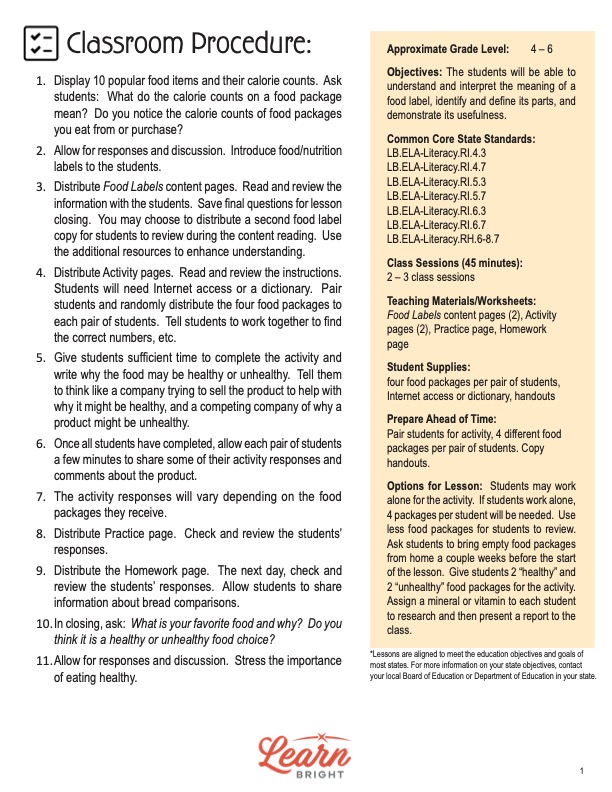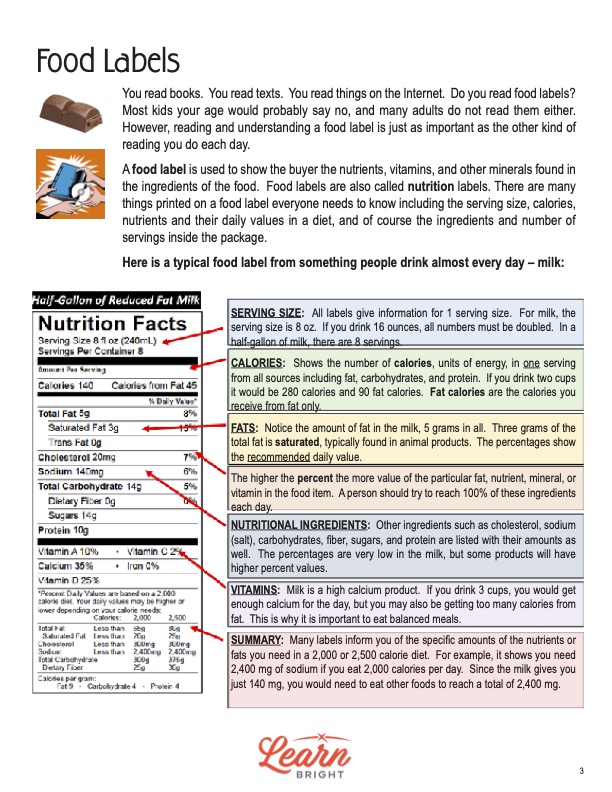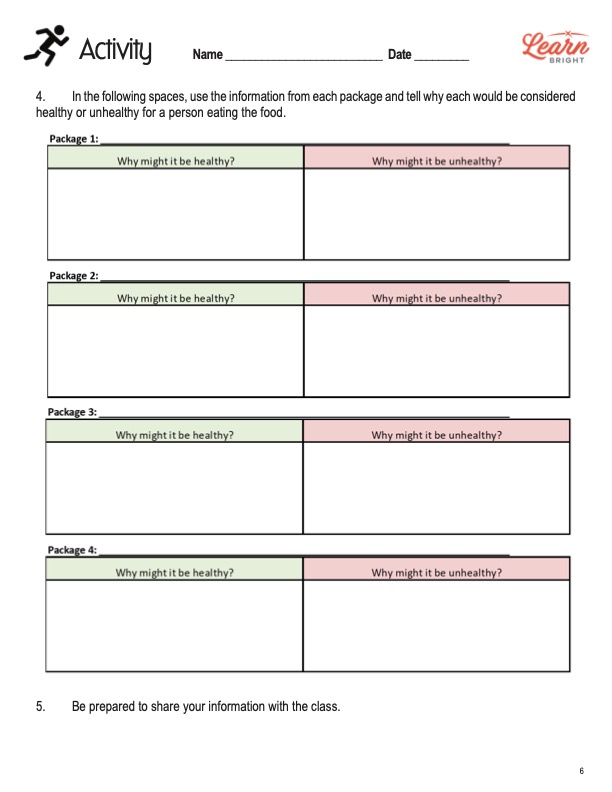Description
What our Food Labels lesson plan includes
Lesson Objectives and Overview: Food Labels introduces students to the important information they would find on packaged food items. Students will discover how to interpret the meaning of each part of the label and define its parts. They will also be able to demonstrate why food labels are useful to consumers. This lesson is for students in 4th grade, 5th grade, and 6th grade.
Classroom Procedure
Every lesson plan provides you with a classroom procedure page that outlines a step-by-step guide to follow. You do not have to follow the guide exactly. The guide helps you organize the lesson and details when to hand out worksheets. It also lists information in the yellow box that you might find useful. You will find the lesson objectives, state standards, and number of class sessions the lesson should take to complete in this area. In addition, it describes the supplies you will need as well as what and how you need to prepare beforehand. This lesson requires just four different food packages per pair of students for the activity.
Options for Lesson
In the “Options for Lesson” section of the classroom procedure page, you will find a number of suggestions for additional activities to do throughout the lesson. Several involve the activity portion. Students could work alone for the activity. If they do, provide four packages per student. Alternatively, you could require fewer food packages for students to review. You could also ask students to bring empty food packages from home a couple weeks before the start of the lesson. You could give students two “healthy” and two “unhealthy” food packages for the activity. Another option is to assign a mineral or vitamin to each student to research. Students can then present reports on what they found.
Teacher Notes
The paragraph on this page provides a little more information or guidance on what to expect from the lesson. It suggests you use actual food labels of products that your students frequently eat. You can use the blank lines to record any thoughts or ideas you have as you prepare.
FOOD LABELS LESSON PLAN CONTENT PAGES
What Is a Food Label?
The Food Labels lesson plan has two content pages. The lesson begins by describing to students how they read books, texts, and things on the internet. It then asks if they read food labels. Most likely, they do not, and they will discover that many adults don’t read them either. However, reading and understanding a food label is quite important.
A food label provides consumers with information on the nutrients, vitamins, and other minerals that a certain food contains. Another term for food label is nutrition label. These labels contain a lot of things that people need to know about the food they eat. For instance, the labels describe the serving size, number of calories, and the daily values of different nutrients and vitamins. It also shows the ingredients that make up the food.
The lesson provides a graphic of a food label and details the different parts. All labels provide information according to one serving size. They also show the number of calories in that serving. Calories are units of energy that come from the fats, proteins, and carbs in that food. A label may also show the number of calories from just fat.
On a food label, the fats section shows the total fat and then often shows specific types of fat. There may be five grams of total fat but three grams of saturated fat, which is a type of fat typically from animals. Students will also notice the percentages on the right side of the label. These represent the daily value of the given nutrients and vitamins.
Nutritional ingredients include cholesterol, sodium, carbs, sugar, and other things. There is also a vitamins section that provides just the daily value percentages for the vitamins found in that food item. At the bottom of the label, there is often a summary section that shows consumers the specific amount of nutrients they need in a certain diet.
Nutrients
Students will learn that a person’s body is unable to make all the nutrients it needs. The reason we eat certain foods is to get the necessary nutrients each day. There are six groups of nutrients that work together to keep a body healthy: carbs, fats, proteins, vitamins, minerals, and water.
Carbs are the main source of energy or calories. Proteins supply energy and amino acids to the body, which help build and repair cells. Fats supply energy and help transport nutrients. They also provide storage and insulation for the body.
Vitamins help our bodies use up the energy we get from food. They all have specific jobs and control chemical reactions. Minerals are similar to vitamins. They help promote reactions and form body structures. Finally, water is a part of every cell and tissue. It carries nutrients, removes waste, and helps the body regulate its temperature.
Ingredients on a Food Label
All food labels list the ingredients of that particular food. Many ingredients are long words that can be hard to pronounce. Some might be additives that give a food its color, allow the food to last longer, or add flavor. The lesson shows a label for peanut butter that contains 20 ingredients. Many experts believe it is best to eat food with more natural ingredients. And foods with the least amount of ingredients are usually the healthier choices.
Processed foods are those we find packaged in bags, boxes, or cans. They usually have the most ingredients and contain large amounts of sodium, fats, and sugar. Not all processed foods are bad for you, but understanding the numbers on their labels will best help us make healthy choices.
On this page are two labels that students can compare to determine which one is healthier. As with all foods, the healthy choice depends on what kinds of nutrients, vitamins, or minerals we want. Label 1 shows 80 calories and fewer nutritional values. Label 2 shows 250 calories and more fat, protein, calcium, sodium, and carbs. That means that label 2 might actually be the healthier choice overall.
FOOD LABELS LESSON PLAN WORKSHEETS
The Food Labels lesson plan includes three worksheets: an activity worksheet, a practice worksheet, and a homework assignment. Each one will help students solidify their grasp of the material they learned throughout the lesson. You can refer to the classroom procedure guidelines to know when to hand out each worksheet.
HEALTHY OR UNHEALTHY ACTIVITY WORKSHEET
Students will need four food packages each and either internet access or a dictionary. For the activity, students will examine the labels on each package they receive. They will choose five of the ingredients on one package and list and define each ingredient. They must also write which item they chose.
Next, they will write the food for each package in the table at the bottom of the worksheet page and fill out the information using the nutrition labels. Finally, they will consider what they learned from each food package and describe why each would be healthy or unhealthy for someone to eat. There are four separate sections for them to write in. After all the students finish, they can share what they learned with the class.
MATCHING AND T/F PRACTICE WORKSHEET
The practice worksheet splits into two sections. On the first section, students will match information to the correct term. There is a word bank on the right of 15 terms to match up. The second section requires students to write whether each of 10 statements is true (T) or false (F).
FOOD LABELS HOMEWORK ASSIGNMENT
For the homework assignment, students will respond to a series of 10 prompts using the information in a bread food label on the page. Then they will use a bread food label from home to fill out the nutritional information of that bread. If they don’t have bread at the time, they can use a different food item. When they finish filling out the nutrition information, they will answer the prompt at the bottom of the page that asks which bread they would eat and why.
Worksheet Answer Keys
The lesson provides answer keys for the practice and homework worksheets. All the correct answers are in red to make it easier to compare them to students’ responses. Given the nature of the second half of the homework assignment, students’ answers will vary. If you choose to administer the lesson pages to your students via PDF, you will need to save a new file that omits these pages. Otherwise, you can simply print out the applicable pages and keep these as reference for yourself when grading assignments.









